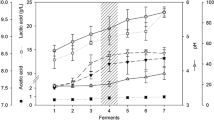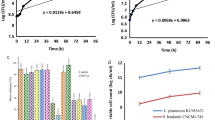Abstract
In this study, effects of 8 different sourdough starters prepared with Saccharomyces cerevisiae, Lactobacillus plantarum, L. acidophilus, and Leuconostoc mesenteroides were investigated on the phytic acid level and mole ratio of phytic acid to zinc in a traditional Iranian bread (sangak). Different sourdough preparations were made and incubated at 30°C for 16 h and added to the dough at 10, 20, and 30% replacement levels. Use of sourdough resulted in a decrease in phytic acid level (also in a decrease in the phytic acid to zinc mole ratio) and corresponding increase in zinc bioavailability index when compared to the commercial sangak bread. The lowest phytic acid concentration and highest zinc bioavailability index were achieved when S. cerevisiae, L. plantarum, and Leu. mesenteroides were used at 30.0% dough replacement with sourdough. This study provides awareness about the negative impacts of higher phytic acid level in the breads, which is particularly the case for sangak bread, and also provides a solution for such issue.
Similar content being viewed by others
References
Roghani D. Sangak Bread — the Study of Sociology. Aktaran Publications, Iran. pp. 34–35 (2007)
Katina K, Salmenkallio-Marittla M, Partanen R, Forssell P, Autio K. Effects of sourdough and enzymes on staling of high-fiber wheat bread. Lebensm. — Wiss. Technol. 39: 479–491 (2006)
Heged H, Pedersen B, Eggum BO. The influence of milling on the nutritive value of flour from cereal grains. 7. Vitamins and tryptophan. Plant Food Hum. Nutr. 35: 175–180 (1985)
Reddy NR, Sathe SK, Salunkhe DK. Phytates in legumes and cereals. Adv. Food Res. 28: 1–92 (1982)
Harland BF, Morris ER. Phytate: A good or a bad food component? Nutr. Res. 15: 733–754 (1995)
Gobbetti M, de Angelis M, Corsetti A, di Cagno R. Biochemistry and physiology of sourdough lactic acid bacteria. Trends Food Sci. Tech. 16: 57–69 (2005)
Nävert B, Sandström B, Cederblad A. Reduction of the phytate content of bran by leavening the bread and its effect on zinc absorption in man. Brit. J. Nutr. 53: 47–53 (1985)
Wood RJ. Assessment of marginal zinc status in humans. J. Nutr. 130: 13505–13545 (2000)
Prasad AS. Discovery and importance of zinc in human nutrition. Fed. Proc. 43: 2829–2834 (1984)
Joung H, Nam G, Yoon S, Lee J, Shim JE, Paik HY. Bioavailable zinc intake of Korean adults in relation to the phytate content of Korean foods. J. Food Compos. Anal. 17: 713–724 (2004)
Liu Z, Wang H, Wang XE, Xu H, Gao D, Zhang G, Chen P, Liu D. Effect of wheat pearling on flour phytase activity, phytic acid, iron, and zinc content. Lebensm. —Wiss. Technol. 41: 521–527 (2008)
Reinhold JG. High phytate content of rural Iranian bread: A possible cause of human zinc eficiency. Am. J. Clin. Nutr. 24: 1204–1206 (1971)
Gargari BP, Mahboob S, Razavieh SV. Content of phytic acid and its mole ratio to zinc in flour and breads in Tabriz, Iran. Food Chem. 100: 1115–1119 (2007)
WHO. Trace Elements in Human Nutrition and Health. World Health Organization, Geneva, Switzerland. p. 361 (1996)
Rukma RN, Shiridhar KS. Introduction. pp. 2–5. In: Food Phytates. Shiridhar KS, Rukma RN (eds). CRC Press, New York, NY, USA (2002)
Payan R. Introduction to Technology of Cereal Products. Nopardazan Publications, Iran. pp. 78–82 (1998)
de Angelis M, Gallo G, Corbo MR, Mc Sweeney PLH, Faccia M, Giovine M, Gobbetti M. Phytase activity in sourdough lactic acid bacteria: Purification and characterization of a phytase from Lactobacillus sanfranciscensis CB1. Int. J. Food Microbiol. 87: 259–270 (2003)
Katina K, Arendt E, Liukkonen KH, Autio K, Flander L, Poutanen K. Potential of sourdough for healthier cereal products. Trends Food Sci. Tech. 16: 104–112 (2005)
Lopez HW, Ouvry A, Bervas E, Guy C, Messager A, Demigne C, Rémésy C. Strains of lactic acid bacteria isolated from sourdoughs degrade phytic acid and improve calcium and magnesium solubility from whole wheat flour. J. Agr. Food Chem. 48: 2281–2285 (2000)
Palacios MC, Haros M, Sanz Y, Cristina RM. Selection of lactic acid bacteria with high phytate degrading activity for application in whole wheat bread making. Lebensm. — Wiss. Technol. 41: 82–92 (2008)
Chaoui A, Faid M, Belhcen R. Effect of natural starters used for sourdough bread in Morocco on phytate degradation. Eastern Mediterranean Health J. 9: 141–147 (2003)
Lopez HW, Krespine V, Guy C, Messager A, Demigne C, Remesy C. Prolonged fermentation of whole wheat sourdough reduces phytate level and increases soluble magnesium. J. Agr. Food Chem. 49: 2657–2662 (2001)
Azar M, Ter-Sarkissian N, Ghavifek H, Ferguson T, Ghassemi H. Microbiological aspects of sangak bread. J. Food. Sci. Technol. 14: 251–254 (1977)
Edema MO, Sanni AI. Functional properties of selected starter cultures for sour maize bread. Food Microbiol. 25: 616–625 (2008)
Yoon KY, Woodams EE, Hang YD. Fermentation of beet juice by beneficial lactic acid bacteria. Lebensm. -Wiss. Technol. 38: 73–75 (2005)
Chavan RS, Chavan SR. Sourdough technology-a traditional way for wholesome foods: A review. Compr. Rev. Food Sci. F. 10: 170–183 (2011)
Dalié DKD, Deschamps AM, Richard-Forget F. Lactic acid bacteria-Potential for control of mould growth and mycotoxins: A review. Food Control 21: 370–380 (2010)
Zhang C, Brandt MJ, Schwab C, Gänzle MG. Propionic acid production by cofermentation of Lactobacillus buchneri and Lactobacillus diolivorans in sourdough. Food Microbiol. 27: 390–395 (2010)
AACC. Approved Method of the AACC. 9th ed. Method 54.21. American Association of Cereal Chemists, St. Paul, MN, USA (1995)
de Man JC, Rogosa M, Sharpe ME. Medium for the cultivation of lactobacilli. J. Appl. Bacteriol. 23: 130–138 (1960)
Zannini E, Garofalo C, Aquilanti L, Santarelli S, Silvestri G, Clementi F. Microbiological and technological characterization of sourdoughs destined for bread-making with barley flour. Food Microbiol. 26: 744–753 (2009)
AOAC. Official Method of Analysis of AOAC Intl. 17th ed. Method 925.09, 923.87, 969.32, 986.11. Association of Official Analytical Communities, Horwitz W, MD, USA (2002)
Simonson L, Salovaara H, Korhola M. Response of wheat sourdough parameters to temperature, NaCl, and sucrose variations. Food Microbiol. 20: 193–199 (2003)
Zotta T, Ricciardi AM, Parente E. Enzymatic activities of lactic acid bacteria isolated from Cornetto di Matera sourdoughs. Int. J. Food Microbiol. 115: 165–172 (2007)
Author information
Authors and Affiliations
Corresponding author
Rights and permissions
About this article
Cite this article
Najafi, M.A., Rezaei, K., Safari, M. et al. Use of sourdough to reduce phytic acid and improve zinc bioavailability of a traditional flat bread (sangak) from Iran. Food Sci Biotechnol 21, 51–57 (2012). https://doi.org/10.1007/s10068-012-0007-3
Received:
Revised:
Accepted:
Published:
Issue Date:
DOI: https://doi.org/10.1007/s10068-012-0007-3




